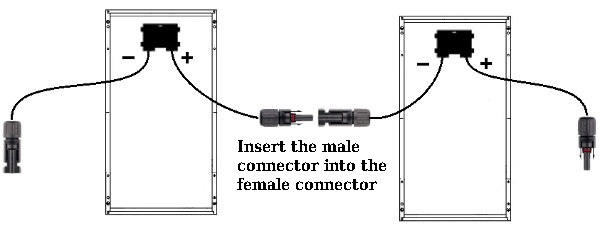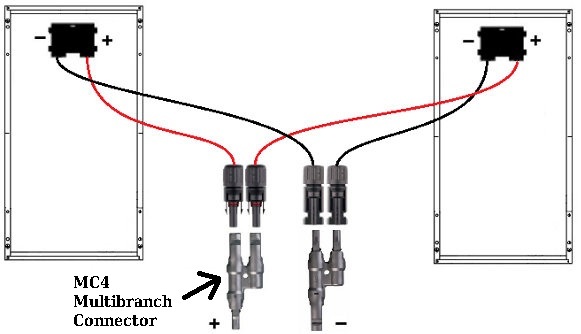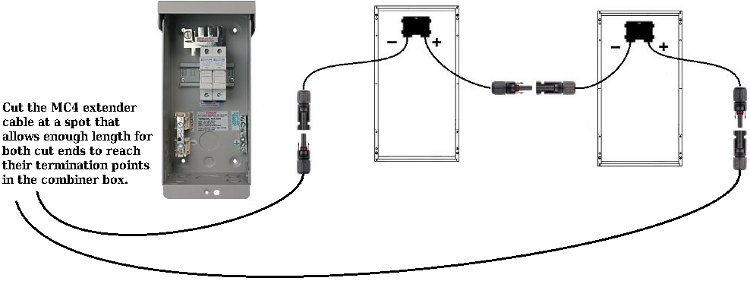How Solar Panel Cables and Connectors Connect to PV Module?
Most high-power solar panels are fabricated from PV cables with MC4 connectors on the ends. Years ago, solar PV modules had a junction box on the back and installers needed to manually connect cables to the positive and negative terminals. This method is still used, but it is slowly being phased out. Today’s solar modules tend to use MC4 plugs because they make wiring the PV array easier and faster. The MC4 plugs are available in male and female styles for snapping together. They meet the requirements of the National Electrical Code, are UL listed, and are the preferred connection method for electrical inspectors. Due to the locking mechanism of the MC4 connectors, they cannot be pulled out, making them ideal for outdoor environments. The connectors can be disconnected with a special MC4 disconnect tool.
How to Wiring MC4 Equipped Solar Panels in Series?
If you have two or more solar panels to be connected in series, using the MC4 PV connector makes the series easy. Take a look at the first PV module in the picture below and you will see that it has two solar PV cables extending of the junction box. One PV cable is DC positive (+) and the other is DC negative (-). Typically, the MC4 female connector is associated with the positive cable and the male connector is associated with the negative cable. But this may not always be the case, so it’s best to check the markings on the PV junction box or use a digital voltmeter to test the polarity. A series connection is when the positive lead on one solar panel is connected to the negative lead on the other solar panel, the male MC4 connector will snap directly into the female connector. The diagram below shows how the MC4 modules are connected in series:
As shown, two solar panels are connected in series by two leads, which increase the voltage of the circuit. For example, if your PV modules are rated at 18 volts at maximum power (Vmp), then two of them connected in series would be 36 Vmp. If you connect three modules in series, the total Vmp will be 54 volts. When the circuit is connected in series, the maximum power current (Imp) will remain the same.
How to Wiring MC4 Equipped Solar Panels in Parallel?
Parallel wiring needs connecting the positive wires together and the negative wires together. This method will increase the current at maximum power (Imp) while keeping the voltage constant. For example, let’s say your solar panels are rated for 8 amps Imp, and 18 volts Vmp. If two of them are connected in parallel, the total amperage will be 16 amps Imp and the voltage will remain at 18 volts Vmp. When connecting two or more solar panels in parallel, you will need some additional equipment. If you’re only using two solar panels, the easiest way is to use the MC4 branch connector. Obviously, you can’t connect two male connectors or two female connectors together, so we’re going to do that with a PV branch connector. There are two different branch connectors. One type accepts two MC4 male connectors on the input side and has one MC4 male connector for the output. The other type accepts two MC4 female connectors and has one MC4 female connector for the output. Essentially, you’ve reduced the number of cables from two positive and two negative to one positive and one negative. As diagram shown below:
If you are paralleling more than two PV modules or paralleling strings of modules, you need a PV combiner box. The combiner box has the same function as the solar branch connector. Solar branch connectors are only suitable for connecting two solar panels in parallel. The total number of solar panels that can be combined will depend on the electrical ratings and physical dimensions of the combiner box. Whether you’re connecting your solar panels with branch connectors or combiner boxes, you need to know how to select and use MC4 extension cables.
How to Use MC4 Solar Extension Cable?
MC4 solar extension cables are very similar in concept to power extension cables. The solar extension cable is the same as the power extension cable, with a male end on one end and a female end on the other end. They come in many different lengths, from 8 feet to 100 feet. After connecting the two solar panels in series, you will need to use an solar extension cord to deliver power to where the electrical equipment is located (usually circuit breakers and solar charge controllers). Photovoltaic systems that use two solar panels are often used in RVs and boats, so solar extension leads can often be used along the entire distance.
When you use solar panels on a roof, the distance the cable has to travel is often so long that using an solar panel extension cable is no longer practical. In these cases, extension cables are used to connect the solar panels to the combiner box. This allows you to use less expensive cables within electrical conduits to cover greater distances at a much lower cost than MC4 cables.
Assume the total cable length required from the two solar panels to your electrical equipment is 20 feet. All you need is an extension cord. We offer a 50-foot solar extension cord that is best for this situation. The two solar panels you have connected together have a positive lead with a MC4 male connector and a negative lead with a MC4 female connector. To reach your device within 20 feet, you’ll need two 20-foot PV cables, one with male and one with female. This is accomplished by cutting a 50-foot solar extension lead in half. This will give you a 25ft lead with a male MC4 connector and a 25ft lead with a female MC4 connector. This allows you to plug in both leads of the solar panel and gives you enough cable to get to your destination. Sometimes cutting the cable in half isn’t always the best solution. Depending on the location of the PV combiner box, the distance from one side of the PV panel string to the combiner box may be greater than the distance from the other side of the PV panel string to the combiner box. In this case, you will need to cut the PV extension cable at a location that allows the two cut ends to reach the combiner box, with a little room for slack. As shown below the diagram:
For systems using PV combiner boxes, you simply select a length that is long enough to terminate into the combiner box when cut. You can then strip the insulation from the cut ends and terminate them to a busbar or circuit breaker.


